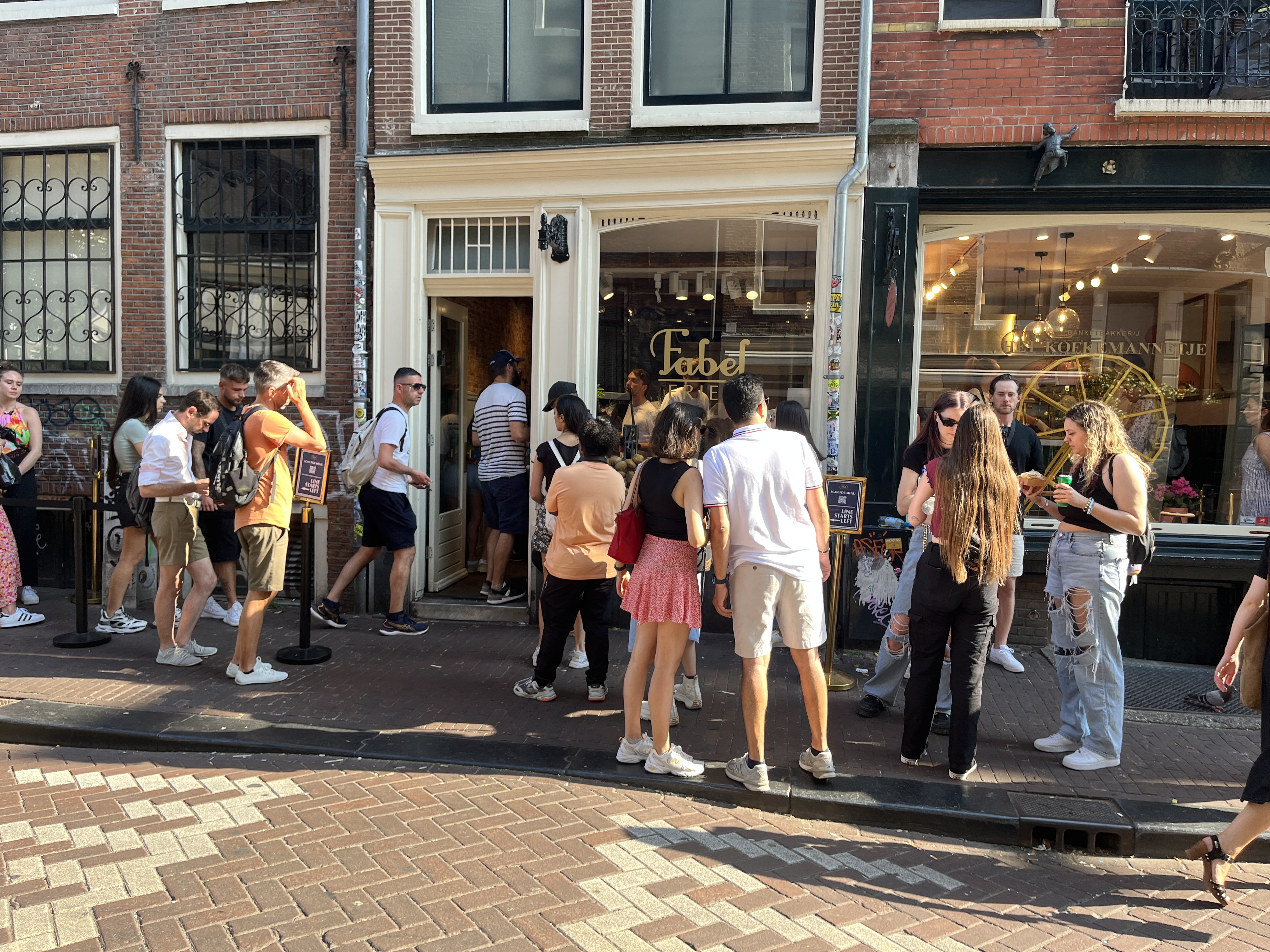“I’ve seen it on social media, and it looks good,” she says. “My generation is more on Instagram, but I have a younger sister, so I saw it on TikTok".
She is one of 23 million overnight tourists expected this year in Amsterdam and is looking to eat in the city’s famous De 9 Straatjes – “nine little streets”. One brick road down, the queue for posh chip shop and fellow social media sensation Fabel Friet stretches across a bridge.
They are symptoms of a certain kind of tourism, inspired more by social media than classic attractions or guidebooks, also seen in Italy and Spain, but very evident in this small, heavily visited country.
While the number of tourists appears to be back at peak 2019 levels, Amsterdammers complain that many appear more inspired by Instagrammable food, lazy bike rides and “window shopping” in the red light district than by the city’s top hotels, museums and galleries.
Some are particularly concerned about social media-influenced flash crowds in places used to a meandering stream. Outside Fabel Friet, a notice asks customers “kindly to respect our neighbours by not eating your fries in front of their houses” while Brenned Tieman on security duty asks tourists to move to the canal to eat their fries with “war” sauce (mayo, satay and onions).
Although Fabel Friet started promoting itself during the pandemic with viral TikTok clips handcutting chips or magically forming them into the shop's name, co-founder Floris Feilzer would prefer a Michelin star to social media fame.
“We are done with the TikToklabel,” he says. “If you don’t have the quality, it won’t come to anything. It’s about having great products, and a heart for the business and for the neighbourhood. A lot of residents come here for chips.”
At Chun cafe, owners Melissa Cheung and Kelvin Chan see things slightly differently: they feel social media – they use Instagram – gives small businesses a democratic and inclusive channel for promotion. “While we don’t actively post on TikTok, we’ve been thrilled to see the spontaneous buzz generated by individuals who share their experiences,” the couple said.

But despite the efforts of both businesses to be good neighbours, around the corner on the Keizersgracht – the most expensive street in the Netherlands – some are unhappy. Multiple signs in windows and on stairs read: “No picnic: please do not sit here.”
A local business owner, who asked not to be named, believes takeaways belong in the red light district. “This is a beautiful place, and now it’s full of eating people,” she says. “It’s not that I don’t want them to have success, but look at it for us: my clients stay away.”
Lony Scharenborg, manager of the De 9 Straatjes shopping area, hopes the trend for performative tourism – copying influencer content – is temporary. “It’s the general public that decides things on TikTok,” she says. “It was all about takeaways – something you don’t expect in the Canal Ring or next to chic hotels. A lot of young people come for chips or a biscuit, which is good for diversity and inclusivity, but if it becomes dominant, other shops will go away.”
In the densely populated, tourist-heavy Netherlands, social media trends are evident. After enduring Instagram-happy visitors rampling the bulb crop, the Dutch tourist board this year imagined a "human proof tulip" for its April fools’ campaign.
“We’re all aware that certain places can suffer from overtourism. We’ve been looking to spread that tourism,” says Simone Sagi of the Netherlands Board of Tourism and Conventions, which uses social media to promote diverse destinations and "slow sundays".
Amsterdam city council points out “it is a worldwide trend that because of social media, certain places and products are visited more for visitors to film or photograph themselves and share” and says it is ensuring businesses reduce nuisance and “keeping a close eye on developments”.
A national law may give councils more power to control soaring numbers of fast food outlets. “And,” adds Scharenborg, “of course it’s never nice to eat on the street.”
According to Dr Joris Demmers, associate professor and head of the marketing department at Amsterdam University’s business school, flash crowds are not good for businesses.
“This is a relatively recent phenomenon so there’s not too much scientific literature, but a few case studies show that for neighbourhoods, destinations and also business owners, it’s very difficult to manage this in a good way,” he says.
“It’s like a plague of locusts: people come, they overwhelm a place, you have capacity problems, you start to think about hiring more people, but a week later they’ve all gone. It’s hard to get a sustainable source of income.” He adds that although social media may feel more “authentic”, it fosters a monoculture since algorithms promote what was successful in the past.
“There are so many good things outside the centre,” says Erik Schmit, tourism spokesman for D66 liberal democrats in Amsterdam, which successfully proposed closing a cruis ship terminal near central station. “My tip: Amsterdam has unique shops, so look in other neighbourhoods.” And for the best tips, adds Demmers: “Talk to the locals.”
Back in the queue for what Fabel Friet aims to make “the tastiest chips in Amsterdam”, this is what British tourists Olive Kennington and George Heading have done, asking the owner of their boat trip where to eat. “You can trust them a bit more,” says Heading. “It’s less of a tourist trap.”

.jpg)
.png)